2022 |
||
| 18. | 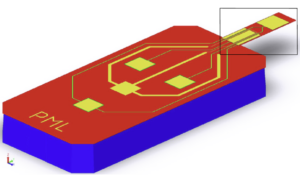 | N. F. S. de Bem; M. G. Ruppert; A. J. Fleming; Y. K. Yong In: Sensors and Actuators A: Physical, vol. 338, pp. 113496, 2022, ISSN: 0924-4247, (This work was supported by the Australian Research Council Discovery Project DP170101813). Abstract | Links | BibTeX | Tags: AFM, DP170101813 @article{J22a,The use of integrated on-chip actuation simplifies the identification of a cantilever resonance, can improve imaging speed, and enables the use of smaller cantilevers, which is required for low-force imaging at high speed. This article describes a cantilever with on-chip actuation and novel dual-sensing capabilities for AFM. The dual-sensing configuration allows for tip displacement and tip force to be measured simultaneously. A mathematical model is developed and validated with finite element analysis. A physical prototype is presented, and its calibration and validation are presented. The cantilever is optimized for use in off-resonance tapping modes. Experimental results demonstrate an agreement between the on-chip sensors and external force and displacement measurements. |
| 17. | 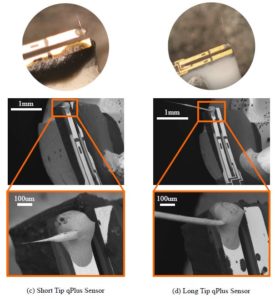 | M. G. Ruppert; D. Martin-Jimenez; Y. K. Yong; A. Ihle; A. Schirmeisen; A. J. Fleming; D. Ebeling Experimental Analysis of Tip Vibrations at Higher Eigenmodes of QPlus Sensors for Atomic Force Microscopy Journal Article In: Nanotechnology, vol. 33, iss. 18, pp. 185503, 2022, ISSN: 1361-6528, (This work was supported in part by the Australian Research Council Discovery Project DP170101813). Abstract | Links | BibTeX | Tags: Actuator, AFM, Cantilever, DP170101813, Multifrequency AFM, piezoelectric @article{Ruppert2022,QPlus sensors are non-contact atomic force microscope probes constructed from a quartz tuning fork and a tungsten wire with an electrochemically etched tip. These probes are self-sensing and offer an atomic-scale spatial resolution. Therefore, qPlus sensors are routinely used to visualize the chemical structure of adsorbed organic molecules via the so-called bond imaging technique. This is achieved by functionalizing the AFM tip with a single CO molecule and exciting the sensor at the first vertical cantilever resonance mode. Recent work using higher-order resonance modes has also resolved the chemical structure of single organic molecules. However, in these experiments, the image contrast can differ significantly from the conventional bond imaging contrast, which was suspected to be caused by unknown vibrations of the tip. This work investigates the source of these artefacts by using a combination of mechanical simulation and laser vibrometry to characterize a range of sensors with different tip wire geometries. The results show that increased tip mass and length cause increased torsional rotation of the tuning fork beam due to the off-center mounting of the tip wire, and increased flexural vibration of the tip. These undesirable motions cause lateral deflection of the probe tip as it approaches the sample, which is rationalized to be the cause of the different image contrast. The results also provide a guide for future probe development to reduce these issues. |
2021 |
||
| 16. | 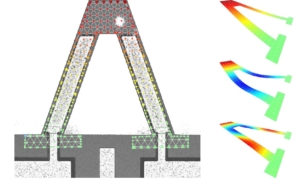 | M. G. Ruppert; N. F. S. de Bem; A. J. Fleming; Y. K. Yong Characterization of Active Microcantilevers Using Laser Doppler Vibrometry Book Chapter In: Vibration Engineering for a Sustainable Future , Chapter 45, Springer, 2021, ISBN: 978-3-030-48153-7, (This work was supported by the Australian Research Council Discovery Project DP170101813). Abstract | Links | BibTeX | Tags: AFM, Cantilever, DP170101813, MEMS, Piezoelectric Transducers and Drives, Smart Structures @inbook{Ruppert2021b,Active atomic force microscope cantilevers with on-chip actuation and sensing provide several advantages over passive cantilevers which rely on piezoacoustic base-excitation and the optical beam deflection measurement. Most importantly, these cantilevers provide clean frequency responses, the possibility of down-scaling and parallelization to cantilever arrays as well as the absence of optical interferences. In this paper, we demonstrate the analysis and calibration steps for three active cantilever geometries with integrated piezoelectric actuation. For this purpose, laser Doppler vibrometry (LDV) is used to experimentally obtain the deflection mode shapes of the first three eigenmodes, calibrate actuation gains, and to determine the dynamic modal stiffnesses using the Brownian spectrum of the cantilever. The experimental values are compared with finite element simulations. |
| 15. | 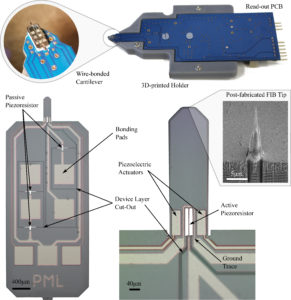 | M. G. Ruppert; A. J. Fleming; Y. K. Yong Active atomic force microscope cantilevers with integrated device layer piezoresistive sensors Journal Article In: Sensors & Actuators: A. Physical, vol. 319, pp. 112519, 2021, ISSN: 0924-4247, (This work was supported by the Australian Research Council Discovery Project DP170101813). Abstract | Links | BibTeX | Tags: AFM, Cantilever, DP170101813, MEMS, Sensors, Smart Structures @article{Ruppert2021,Active atomic force microscope cantilevers with on-chip actuation and sensing provide several advantages over passive cantilevers which rely on piezoacoustic base-excitation and optical beam deflection measurement. Active microcantilevers exhibit a clean frequency response, provide a path-way to miniturization and parallelization and avoid the need for optical alignment. However, active microcantilevers are presently limited by the feedthrough between actuators and sensors, and by the cost associated with custom microfabrication. In this work, we propose a hybrid cantilever design with integrated piezoelectric actuators and a piezoresistive sensor fabricated from the silicon device layer without requiring an additional doping step. As a result, the design can be fabricated using a commercial five-mask microelectromechanical systems fabrication process. The theoretical piezoresistor sensitivity is compared with finite element simulations and experimental results obtained from a prototype device. The proposed approach is demonstrated to be a promising alternative to conventional microcantilever actuation and deflection sensing |
2020 |
||
| 14. | 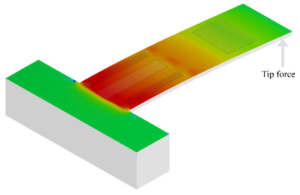 | N. F. S. de Bem; M. G. Ruppert; Y. K. Yong; A. J. Fleming Integrated force and displacement sensing in active microcantilevers for off-resonance tapping mode atomic force microscopy Proceedings Article In: International Conference on Manipulation, Automation and Robotics at Small Scales (MARSS), pp. 1-6, 2020, (This work was supported by the Australian Research Council Discovery Project DP170101813). Abstract | Links | BibTeX | Tags: AFM, DP170101813, MEMS, SPM @inproceedings{C20c,Integrated on-chip actuation and sensing in microcantilevers for atomic force microscopy (AFM) allows faster scanning speeds, cleaner frequency responses and smaller cantilevers. However, a single integrated sensor suffers from crosscoupling between displacements originating from tip-sample forces and direct actuation. This paper addresses this issue by presenting a novel microcantilever with on-chip actuation and integrated dual sensing for AFM with application to offresonance tapping modes in AFM. The proposed system is able to measure tip force and deflection simultaneously. A mathematical model is developed for a rectangular cantilever to describe the system and is validated with finite element analysis. |
| 13. | 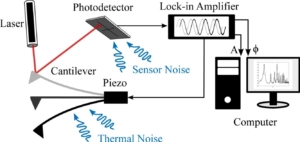 | M. G. Ruppert; N. J. Bartlett; Y. K. Yong; A. J. Fleming Amplitude Noise Spectrum of a Lock-in Amplifier: Application to Microcantilever Noise Measurements Journal Article In: Sensors and Actuators A: Physical, vol. 312, pp. 112092, 2020, (This work was supported by the Australian Research Council Discovery Project DP170101813). Abstract | Links | BibTeX | Tags: AFM, Cantilever, Demodulation, DP170101813, MEMS, System Identification @article{Ruppert2020,The lock-in amplifier is a crucial component in many applications requiring high-resolution displacement sensing; it's purpose is to estimate the amplitude and phase of a periodic signal, potentially corrupted by noise, at a frequency determined by a reference signal. Where the noise can be approximated by a stationary Gaussian process, such as thermal force noise and electronic sensor noise, this article derives the amplitude noise spectral density of the lock-in-amplifier output. The proposed method is demonstrated by predicting the demodulated noise spectrum of a microcantilever for dynamic-mode atomic force microscopy to determine the cantilever on-resonance thermal noise, the cantilever tracking bandwidth and the electronic noise floor. The estimates are shown to closely match experimental results over a wide range of operating conditions. |
| 12. | 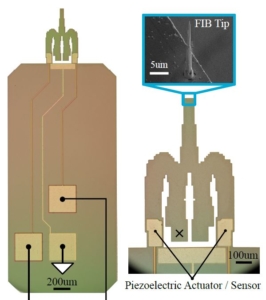 | S. I. Moore; M. G. Ruppert; Y. K. Yong AFM Cantilever Design for Multimode Q Control: Arbitrary Placement of Higher-Order Modes Journal Article In: IEEE/ASME Transactions on Mechatronics, pp. 1-6, 2020, (This work was supported by the Australian Research Council Discovery Project DP170101813). Abstract | Links | BibTeX | Tags: AFM, Cantilever, DP170101813, MEMS, Multifrequency AFM, Smart Structures, SPM, Vibration Control @article{Moore2020,In the fast growing field of multifrequency atomic force microscopy (AFM), the benefits of using higher-order modes has been extensively reported on. However, higher modes of AFM cantilevers are difficult to instrument and Q control is challenging owing to their high frequency nature. At these high frequencies, the latencies in the computations and analog conversions of digital signal processing platforms become significant and limit the effective bandwidth of digital feedback controller implementations. To address this issue, this article presents a novel cantilever design for which the first five modes are placed within a 200 kHz bandwidth. The proposed cantilever is designed using a structural optimization routine. The close spacing and low mechanical bandwidth of the resulting cantilever allows for the implementation of Q controllers for all five modes using a standard FPGA development board for bimodal AFM and imaging on higher-order modes. |
2019 |
||
| 11. | 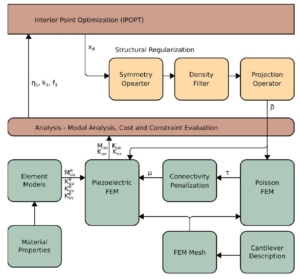 | S. I. Moore; M. G. Ruppert; Y. K. Yong An optimization framework for the design of piezoelectric AFM cantilevers Journal Article In: Precision Engineering, vol. 60, pp. 130-142, 2019, (This work was supported by the Australian Research Council Discovery Project DP170101813). Abstract | Links | BibTeX | Tags: AFM, Cantilever, DP170101813, MEMS, Piezoelectric Transducers and Drives, Smart Structures, SPM @article{Moore2019c,To facilitate further miniaturization of atomic force microscopy (AFM) cantilevers and to eliminate the standard optical beam deflection sensor, integrated piezoelectric actuation and sensing on the chip level is a promising option. This article presents a topology optimization method for dynamic mode AFM cantilevers that maximizes the sensitivity of an integrated piezoelectric sensor under stiffness and resonance frequency constraints. Included in the formulation is a new material model C-SIMP (connectivity and solid isotropic material with penalization) that extends the SIMP model to explicitly include the penalization of unconnected structures. Example cantilever designs demonstrate the potential of the topology optimization method. The results show, firstly, the C-SIMP material model significantly reduces connectivity issues and, secondly, arbitrary cantilever topologies can produce increases in sensor sensitivity or resonance frequency compared to a rectangular topology. |
| 10. | 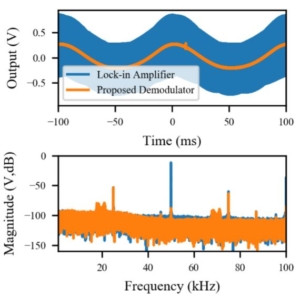 | S. I. Moore; M. G. Ruppert; D. M. Harcombe; A. J. Fleming; Y. K. Yong Design and Analysis of Low-Distortion Demodulators for Modulated Sensors Journal Article In: IEEE/ASME Transactions on Mechatronics, vol. 24, no. 4, pp. 1861-1870, 2019, ISSN: 10834435, (This work was supported by the Australian Research Council Discovery Project DP170101813). Abstract | Links | BibTeX | Tags: Demodulation, DP170101813, Multifrequency AFM, Nanopositioning, SPM @article{Moore2019,System-based demodulators in the form of a Kalman and Lyapunov filter have been demonstrated to significantly outperform traditional demodulators, such as the lock-in amplifier, in bandwidth sensitive applications, for example high-speed atomic force microscopy. Building on their closed loop architecture, this article describes a broader class of high-speed closed-loop demodulators. The generic structure provides greater flexibility to independently control the bandwidth and sensitivity to out-of-band frequencies. A linear time-invariant description is derived which allows the utilization of linear control theory to design the demodulator. Experimental results on a nanopositioner with capacitive sensors demonstrate the realization of arbitrary demodulator dynamics while achieving excellent noise rejection. |
| 9. | 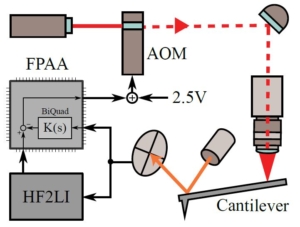 | M. G. Ruppert; B. S. Routley; A. J. Fleming; Y. K. Yong; G. E. Fantner Model-based Q Factor Control for Photothermally Excited Microcantilevers Proceedings Article In: Int. Conference on Manipulation, Automation and Robotics at Small Scales (MARSS), Helsinki, Finland, 2019, ISSN: 978-1-7281-0948-0, (This work was supported by the Australian Research Council Discovery Project DP170101813). Abstract | Links | BibTeX | Tags: AFM, DP170101813, Multifrequency AFM, Sensors, Smart Structures, SPM, Vibration Control @inproceedings{Ruppert2019,Photothermal excitation of the cantilever for dynamic atomic force microscopy (AFM) modes is an attractive actuation method as it provides clean cantilever actuation leading to well-defined frequency responses. Unlike conventional piezo-acoustic excitation of the cantilever, it allows for model-based quality (Q) factor control in order to increase the cantilever tracking bandwidth for tapping-mode AFM or to reduce resonant ringing for high-speed photothermal offresonance tapping (PORT) in ambient conditions. In this work, we present system identification, controller design and experimental results on controlling the Q factor of a photothermally driven cantilever. The work is expected to lay the groundwork for future implementations for high-speed PORT imaging in ambient conditions. |
| 8. | 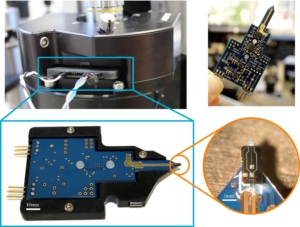 | M. G. Ruppert; S. I. Moore; M. Zawierta; A. J. Fleming; G. Putrino; Y. K. Yong Multimodal atomic force microscopy with optimized higher eigenmode sensitivity using on-chip piezoelectric actuation and sensing Journal Article In: Nanotechnology, vol. 30, no. 8, pp. 085503, 2019, (This work was supported by the Australian Research Council Discovery Project DP170101813). Abstract | Links | BibTeX | Tags: AFM, Cantilever, DP170101813, MEMS, Multifrequency AFM, Piezoelectric Transducers and Drives, Sensors, Smart Structures, SPM @article{Ruppert2018b,Atomic force microscope (AFM) cantilevers with integrated actuation and sensing provide several distinct advantages over conventional cantilever instrumentation. These include clean frequency responses, the possibility of down-scaling and parallelization to cantilever arrays as well as the absence of optical interference. While cantilever microfabrication technology has continuously advanced over the years, the overall design has remained largely unchanged; a passive rectangular shaped cantilever design has been adopted as the industry wide standard. In this article, we demonstrate multimode AFM imaging on higher eigenmodes as well as bimodal AFM imaging with cantilevers using fully integrated piezoelectric actuation and sensing. The cantilever design maximizes the higher eigenmode deflection sensitivity by optimizing the transducer layout according to the strain mode shape. Without the need for feedthrough cancellation, the read-out method achieves close to zero actuator/sensor feedthrough and the sensitivity is sufficient to resolve the cantilever Brownian motion. |
2018 |
||
| 7. | 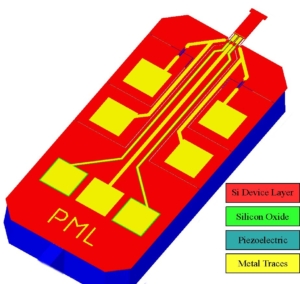 | M. G. Ruppert; Y. K. Yong Design of Hybrid Piezoelectric/Piezoresistive Cantilevers for Dynamic-mode Atomic Force Microscopy Proceedings Article In: IEEE/ASME Advanced Intelligent Mechatronics (AIM), Auckland, New Zealand, 2018, (This work was supported by the Australian Research Council Discovery Project DP170101813). Abstract | BibTeX | Tags: AFM, Cantilever, DP170101813, MEMS, Piezoelectric Transducers and Drives, Sensors, Smart Structures, SPM @inproceedings{Ruppert2018b,Atomic force microscope cantilevers with integrated actuation and sensing on the chip level provide several distinct advantages over conventional cantilever instrumentation. These include clean frequency responses, the possibility of down-scaling and parallelization to cantilever arrays as well as the absence of optical interferences. However, the two major difficulties with integrated transduction methods are a complicated fabrication process, often involving a number of fabrication steps, and a high amount of feedthrough from actuation to sensing electrodes. This work proposes two hybrid cantilever designs with piezoelectric actuators and piezoresistive sensors to reduce the actuator to sensor feedthrough. The designs can be realized using a commercial microelectromechanical systems fabrication process and only require a simple five-mask patterning and etching process. Finite element analysis results are presented to obtain modal responses, actuator gain and sensor sensitivities of the cantilever designs. |
| 6. |  | S. I. Moore; M. G. Ruppert; Y. K. Yong Arbitrary placement of AFM cantilever higher eigenmodes using structural optimization Proceedings Article In: International Conference on Manipulation, Automation and Robotics at Small Scales (MARSS), 2018, (This work was supported by the Australian Research Council Discovery Project DP170101813). Abstract | BibTeX | Tags: AFM, Cantilever, DP170101813, MEMS, Multifrequency AFM, Piezoelectric Transducers and Drives, Sensors, SPM, System Identification @inproceedings{Moore2018,This article presents a novel cantilever design approach to place higher mode frequencies within a specific frequency band to alleviate instrumentation and Q control feasibility. This work is motivated by the emerging field of multifrequency atomic force microscopy (AFM) which involves the excitation and/or detection of several cantilever modes at once. Unlike other operating modes, multifrequency AFM allows the tracking of the sample topography on the fundamental mode while simultaneously acquiring complimentary nanomechanical information on a higher mode. However, higher modes of conventional rectangular tapping-mode cantilevers are usually in the MHz regime and therefore impose severe restrictions on the direct controllability of these modes. To overcome this limitation, an optimization technique is employed which is capable of placing the first five modes within a 200 kHz bandwidth. |
| 5. | 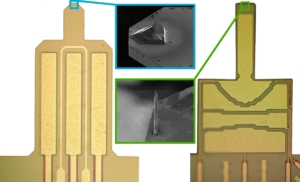 | M. G. Ruppert; S. I. Moore; M. Zawierta; G. Putrino; Y. K. Yong Advanced Sensing and Control with Active Cantilevers for Multimodal Atomic Force Microscopy Conference 7th Multifrequency AFM Conference, Madrid, Spain, 2018, (This work was supported by the Australian Research Council Discovery Project DP170101813). Abstract | BibTeX | Tags: AFM, Cantilever, DP170101813, MEMS, Multifrequency AFM, Sensors, Smart Structures, SPM, Vibration Control @conference{Ruppert2018,Atomic force microscopy (AFM) cantilevers with integrated actuation and sensing on the chip level provide several distinct advantages over conventional cantilever instrumentation. These include clean frequency responses, the possibility of down-scaling and parallelization to cantilever arrays as well as the absence of optical interferences. While cantilever microfabrication technology has continuously advanced over the years, the overall design has remained largely unchanged; a passive rectangular shaped cantilever design has been adopted as the industry wide standard. Consequently, conventional cantilever instrumentation requires external piezo acoustic excitation as well as an external optical deflection sensor. Both of these components are not optimal for current trends in multifrequency AFM technology which revolve around further down-sizing, parallelization and measurements at multiple higher eigenmodes. Using microelectromechanical systems (MEMS) fabrication processes, this work aims to optimize cantilever instrumentation by realizing a new class of probes with high-performance integrated actuators and sensors. Equipped with multiple integrated piezoelectric layers for both actuation and sensing, these cantilevers are capable of achieving an increased higher eigenmode sensitivity and/or guaranteed collocated system properties compared to commercially available counterparts; examples of such designs are shown in Figure 1. The geometry as well as the integrated actuator/sensor arrangement is optimized using finite element modelling with individual design goals. The designs are realized using a commercial MEMS fabrication process and only require a simple five-mask patterning and etching process and post-fabricated sharp tips. |
2017 |
||
| 4. | 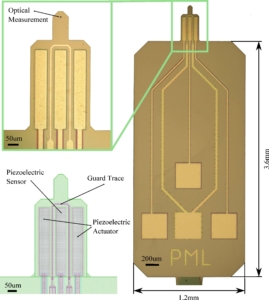 | M. G. Ruppert; Y. K. Yong Note: Guaranteed collocated multimode control of an atomic force microscope cantilever using on-chip piezoelectric actuation and sensing Journal Article In: Review of Scientific Instruments, vol. 88, no. 086109, 2017, (This work was supported by the Australian Research Council Discovery Project DP170101813). Abstract | Links | BibTeX | Tags: AFM, Cantilever, DP170101813, MEMS, Multifrequency AFM, Piezoelectric Transducers and Drives, System Identification, Vibration Control @article{Ruppert2017b,The quality (Q) factor is an important parameter of the resonance of the microcantilever as it determines both imaging bandwidth and force sensitivity. The ability to control the Q factor of multiple modes is believed to be of great benefit for atomic force microscopy techniques involving multiple eigenmodes. In this paper, we propose a novel cantilever design employing multiple piezoelectric transducers which are used for separated actuation and sensing, leading to guaranteed collocation of the first eight eigenmodes up to 3 MHz. The design minimizes the feedthrough usually observed with these systems by incorporating a guard trace on the cantilever chip. As a result, a multimode Q controller is demonstrated to be able to modify the quality factor of the first two eigenmodes over up to four orders of magnitude without sacrificing robust stability. |
| 3. | 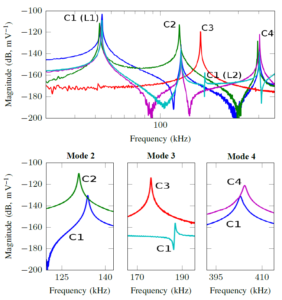 | S. I. Moore; M. G. Ruppert; Y. K. Yong Design and Analysis of Piezoelectric Cantilevers with Enhanced Higher Eigenmodes for Atomic Force Microscopy Proceedings Article In: IEEE/ASME Advanced Intelligent Mechatronics (AIM), Munich, Germany, 2017, (This work was supported by the Australian Research Council Discovery Project DP170101813). Abstract | BibTeX | Tags: DP170101813, Multifrequency AFM, SPM @inproceedings{Moore2017b,Atomic force microscope (AFM) cantilevers with integrated actuation and sensing provide several distinct advantages over conventional cantilever instrumentation such as clean frequency responses, the possibility of down-scaling and parallelization to cantilever arrays as well as the absence of optical interferences. However, for multifrequency AFM techniques involving higher eigenmodes of the cantilever, optimization of the transducer location and layout has to be taken into account. This work proposes multiple integrated piezoelectric regions on the cantilever which maximize the deflection of the cantilever and the piezoelectric charge response for a given higher eigenmode based on the spatial strain distribution. Finite element analysis is performed to find the optimal transducer topology and experimental results are presented which highlight an actuation gain improvement up to 42 dB on the third mode and sensor sensitivity improvement up to 38 dB on the second mode. |
| 2. | 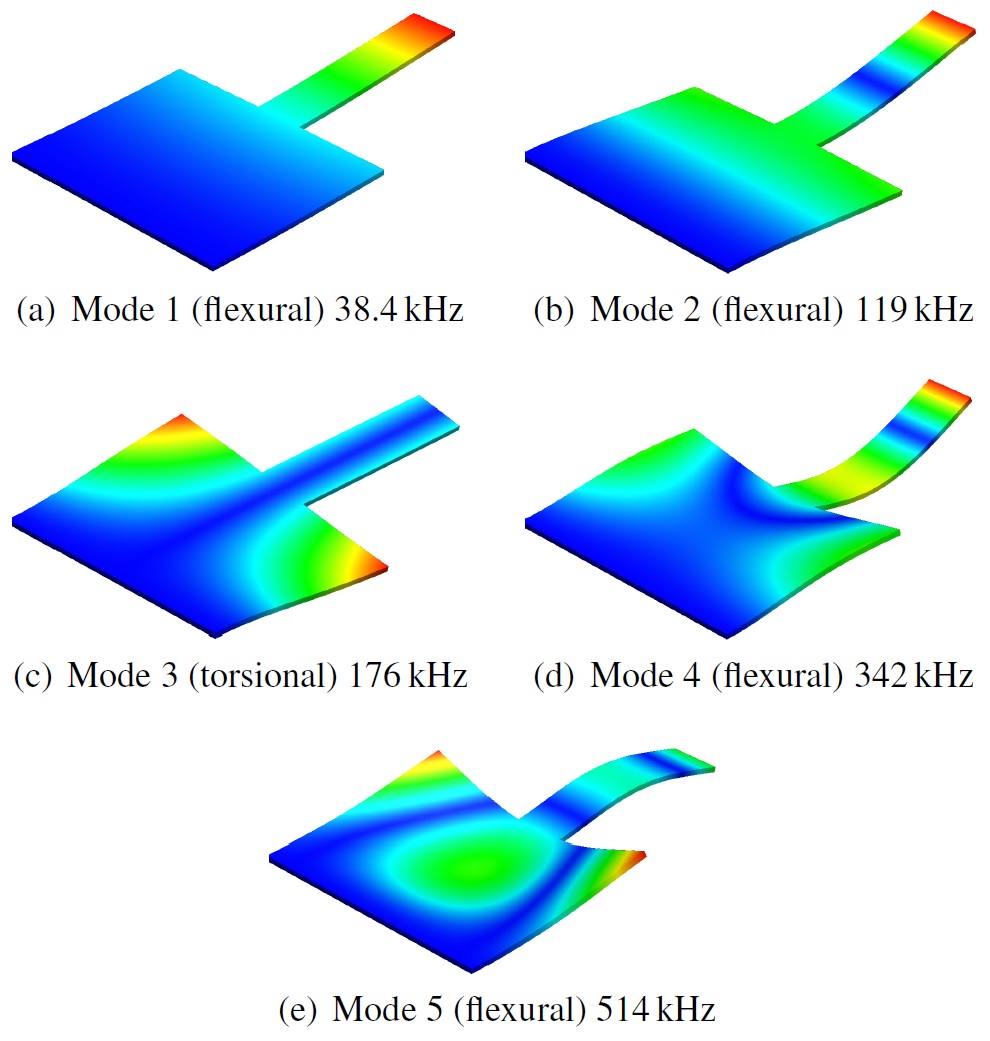 | S. I. Moore; Y. K. Yong Design and Characterization of Cantilevers for Multi-Frequency Atomic Force Microscopy Journal Article In: Micro & Nano Letters, vol. 12, no. 5, pp. 315-320, 2017, (This work was supported by the Australian Research Council Discovery Project DP170101813). Abstract | Links | BibTeX | Tags: Cantilever, DP170101813, MEMS, Multifrequency AFM, SPM @article{Moore2017,The experimental characterisation of a set of microcantilevers targeted at use in multi-frequency atomic force microscope is presented. The aim of this work is to design a cantilever that naturally amplifies its harmonic oscillations which are introduced by nonlinear probe–sample interaction forces. This is performed by placing the modal frequencies of the cantilever at integer multiples of the first modal frequency. The developed routine demonstrates the placement of the frequency of the second to fifth mode. The characterisation shows a trend that lower-order modes are more accurately placed than higher-order modes. With two fabricated designs, the error in the second mode is at most 2.26% while the greatest error in the fifth mode is at 10.5%. |
| 1. | 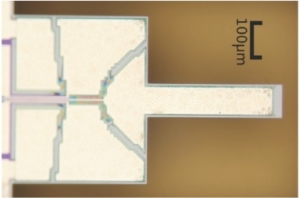 | S. I. Moore; M. G. Ruppert; Y. K. Yong Multimodal cantilevers with novel piezoelectric layer topology for sensitivity enhancement Journal Article In: Beilstein Journal of Nanotechnology, vol. 8, pp. 358–371, 2017, (This work was supported by the Australian Research Council Discovery Project DP170101813). Abstract | Links | BibTeX | Tags: Cantilever, DP170101813, Multifrequency AFM, Piezoelectric Transducers and Drives, SPM @article{Moore2017b,Self-sensing techniques for atomic force microscope (AFM) cantilevers have several advantageous characteristics compared to the optical beam deflection method. The possibility of down scaling, parallelization of cantilever arrays and the absence of optical interference associated imaging artifacts have led to an increased research interest in these methods. However, for multifrequency AFM, the optimization of the transducer layout on the cantilever for higher order modes has not been addressed. To fully utilize an integrated piezoelectric transducer, this work alters the layout of the piezoelectric layer to maximize both the deflection of the cantilever and measured piezoelectric charge response for a given mode with respect to the spatial distribution of the strain. On a prototype cantilever design, significant increases in actuator and sensor sensitivities were achieved for the first four modes without any substantial increase in sensor noise. The transduction mechanism is specifically targeted at multifrequency AFM and has the potential to provide higher resolution imaging on higher order modes. |
2022 |
||
| 18. |  | In: Sensors and Actuators A: Physical, vol. 338, pp. 113496, 2022, ISSN: 0924-4247, (This work was supported by the Australian Research Council Discovery Project DP170101813). |
| 17. |  | Experimental Analysis of Tip Vibrations at Higher Eigenmodes of QPlus Sensors for Atomic Force Microscopy Journal Article In: Nanotechnology, vol. 33, iss. 18, pp. 185503, 2022, ISSN: 1361-6528, (This work was supported in part by the Australian Research Council Discovery Project DP170101813). |
2021 |
||
| 16. |  | Characterization of Active Microcantilevers Using Laser Doppler Vibrometry Book Chapter In: Vibration Engineering for a Sustainable Future , Chapter 45, Springer, 2021, ISBN: 978-3-030-48153-7, (This work was supported by the Australian Research Council Discovery Project DP170101813). |
| 15. |  | Active atomic force microscope cantilevers with integrated device layer piezoresistive sensors Journal Article In: Sensors & Actuators: A. Physical, vol. 319, pp. 112519, 2021, ISSN: 0924-4247, (This work was supported by the Australian Research Council Discovery Project DP170101813). |
2020 |
||
| 14. |  | Integrated force and displacement sensing in active microcantilevers for off-resonance tapping mode atomic force microscopy Proceedings Article In: International Conference on Manipulation, Automation and Robotics at Small Scales (MARSS), pp. 1-6, 2020, (This work was supported by the Australian Research Council Discovery Project DP170101813). |
| 13. |  | Amplitude Noise Spectrum of a Lock-in Amplifier: Application to Microcantilever Noise Measurements Journal Article In: Sensors and Actuators A: Physical, vol. 312, pp. 112092, 2020, (This work was supported by the Australian Research Council Discovery Project DP170101813). |
| 12. |  | AFM Cantilever Design for Multimode Q Control: Arbitrary Placement of Higher-Order Modes Journal Article In: IEEE/ASME Transactions on Mechatronics, pp. 1-6, 2020, (This work was supported by the Australian Research Council Discovery Project DP170101813). |
2019 |
||
| 11. |  | An optimization framework for the design of piezoelectric AFM cantilevers Journal Article In: Precision Engineering, vol. 60, pp. 130-142, 2019, (This work was supported by the Australian Research Council Discovery Project DP170101813). |
| 10. |  | Design and Analysis of Low-Distortion Demodulators for Modulated Sensors Journal Article In: IEEE/ASME Transactions on Mechatronics, vol. 24, no. 4, pp. 1861-1870, 2019, ISSN: 10834435, (This work was supported by the Australian Research Council Discovery Project DP170101813). |
| 9. |  | Model-based Q Factor Control for Photothermally Excited Microcantilevers Proceedings Article In: Int. Conference on Manipulation, Automation and Robotics at Small Scales (MARSS), Helsinki, Finland, 2019, ISSN: 978-1-7281-0948-0, (This work was supported by the Australian Research Council Discovery Project DP170101813). |
| 8. |  | Multimodal atomic force microscopy with optimized higher eigenmode sensitivity using on-chip piezoelectric actuation and sensing Journal Article In: Nanotechnology, vol. 30, no. 8, pp. 085503, 2019, (This work was supported by the Australian Research Council Discovery Project DP170101813). |
2018 |
||
| 7. |  | Design of Hybrid Piezoelectric/Piezoresistive Cantilevers for Dynamic-mode Atomic Force Microscopy Proceedings Article In: IEEE/ASME Advanced Intelligent Mechatronics (AIM), Auckland, New Zealand, 2018, (This work was supported by the Australian Research Council Discovery Project DP170101813). |
| 6. |  | Arbitrary placement of AFM cantilever higher eigenmodes using structural optimization Proceedings Article In: International Conference on Manipulation, Automation and Robotics at Small Scales (MARSS), 2018, (This work was supported by the Australian Research Council Discovery Project DP170101813). |
| 5. |  | Advanced Sensing and Control with Active Cantilevers for Multimodal Atomic Force Microscopy Conference 7th Multifrequency AFM Conference, Madrid, Spain, 2018, (This work was supported by the Australian Research Council Discovery Project DP170101813). |
2017 |
||
| 4. |  | Note: Guaranteed collocated multimode control of an atomic force microscope cantilever using on-chip piezoelectric actuation and sensing Journal Article In: Review of Scientific Instruments, vol. 88, no. 086109, 2017, (This work was supported by the Australian Research Council Discovery Project DP170101813). |
| 3. |  | Design and Analysis of Piezoelectric Cantilevers with Enhanced Higher Eigenmodes for Atomic Force Microscopy Proceedings Article In: IEEE/ASME Advanced Intelligent Mechatronics (AIM), Munich, Germany, 2017, (This work was supported by the Australian Research Council Discovery Project DP170101813). |
| 2. |  | Design and Characterization of Cantilevers for Multi-Frequency Atomic Force Microscopy Journal Article In: Micro & Nano Letters, vol. 12, no. 5, pp. 315-320, 2017, (This work was supported by the Australian Research Council Discovery Project DP170101813). |
| 1. |  | Multimodal cantilevers with novel piezoelectric layer topology for sensitivity enhancement Journal Article In: Beilstein Journal of Nanotechnology, vol. 8, pp. 358–371, 2017, (This work was supported by the Australian Research Council Discovery Project DP170101813). |
